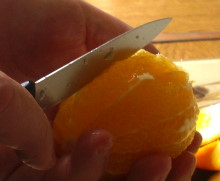Baked Cheesecake With Oranges, Honey And Walnuts
By Mike on Sunday, August 9, 2009, 19:48 - Permalink
This is a recipe for a rich baked cheesecake that can be eaten on its own or topped with fruit or other sweet things. I topped this one with fresh orange segments, honey and walnuts - it was fantastic.
The Recipe
Ingredients:
For The Base
- 100g Digestive biscuits, crushed
- 50g Butter
- 25g Demerera sugar
For The Cheesecake Layer
- 400g Curd cheese or other soft, mild white cream cheese
- 100g Caster sugar
- 25g Plain flour
- 3 Eggs
- 50ml Milk
- Juice and finely grated rind of one orange
- 50g Soft butter or margarine
For The Topping
- Two large oranges
- Clear honey
- Walnut pieces
Method:
Make the base by melting the butter and mixing in the sugar and biscuit crumbs - spread this into the bottom of a 7 inch loose-bottomed cake tin.
Flatten it down firmly with the base of a tumbler, then place in the fridge to set.
Use a fine grater or citrus zester to pare off the rind of the orange - chop this into smaller pieces.
Juice the orange after zesting - the juice is one of the ingredients for the cheesecake layer mix.
 Preheat your oven to 150C
Preheat your oven to 150C
Place all of the cheesecake ingredients in a big bowl together.
Beat the ingredients together for a minute or two until fully combined
The lumps you see in this picture are just bubbles, but don't worry too much if there are still some tiny specks of cheese that appear unmixed.
Pour the cheesecake mixture on top of the biscuit base.
Place the tin inside a larger tin or oven-proof dish or tray (in case anything leaks out of the loose bottom).
Bake in the oven for an hour and a half, or until the top turns light golden brown and the cheesecake doesn't wobble too much when gently agitated.
Allow to cool for about five minutes, then run a knife carefully around the inside of the tin to loosen the cheesecake.
When fully cooled, run a knife around the inside of the tin again and push up the loose bottom.
(I find the easiest way to do this is to stand it on a big mug and press the side rim of the tin downwards, leaving the loose base standing proud on the mug)
Preparing The Oranges
Here's how to get perfect segments of orange without any pith or membrane...
Start by slicing off both ends of the orange - just enough that you can see the juicy flesh inside.
Place one of the cut ends on a flat surface and, using a sharp, thin-bladed knife, carefully slice away the skin in strips - following the curve of the orange flesh.
When you've removed all of the skin and pith, you can release the flesh from each segment by making two cuts in a V shape, just inside the segment membrane
 Once cut, the flesh from each segment should lift out cleanly and easily
Once cut, the flesh from each segment should lift out cleanly and easily
Repeat for each segment - then when you've removed them all, use your hands to squeeze the juice out of the remaining parts of the orange into your bowl of cut segments.
Chill in the fridge for at least an hour before serving.
You can either add the toppings all at once before bringing to the table, or (as I did) serve them in separate dishes to be spooned over the wedges of cheesecake after cutting.
Variations
This basic cheesecake base can be used with any sweet or fruity topping you can imagine.
If you're topping it with less acid fruits such as grapes or pears, you may wish to substitute a lemon for the orange in the cheesecake mixture - the sharper-tasting cake will offset the sweet fruit beautifully.
By design, this cheesecake is meant to be rich and substantial - but if you prefer a lighter texture, separate the eggs when making the cheesecake layer - mix everything together with the egg yolks, but set aside the whites. Whisk the whites separately until stiff and fluffy, then fold them gently into the rest of the mixture immediately before baking.
